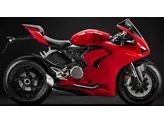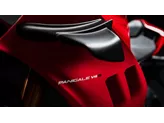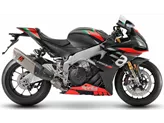Ducati Panigale V4 2018 vs. Yamaha R1 2015

Ducati Panigale V4 2018

Yamaha R1 2015
Vue d’ensemble - Ducati Panigale V4 2018 vs Yamaha R1 2015
The Ducati Panigale V4 2018 and the Yamaha R1 2015 are both powerful supersport motorcycles with impressive technical specifications. However, they have some distinct differences in terms of their engine, chassis, assistance systems, and dimensions.
In terms of engine and drive train, the Ducati Panigale V4 2018 has a larger bore and stroke compared to the Yamaha R1 2015. This results in a higher engine power of 214 HP and torque of 124 Nm for the Panigale V4, while the R1 has 200 HP and 112.4 Nm of torque. The Panigale V4 also has a higher compression ratio of 14 compared to the R1's 13. Both motorcycles have 4 cylinders and 4 valves per cylinder, but the Panigale V4 features desmodromic valves, while the R1 has DOHC valves. Additionally, the Panigale V4 has a larger displacement of 1103 ccm, while the R1 has 998 ccm.
In terms of suspension, both motorcycles feature upside-down telescopic forks in the front. The Panigale V4 has a monocoque frame made of aluminum, while the R1 has a Deltabox frame also made of aluminum. Both motorcycles have double disk brakes in the front.

Ducati Panigale V4 2018
When it comes to assistance systems, the Panigale V4 is equipped with ABS, while the R1 has additional features such as launch control and traction control. These advanced rider assistance systems provide added safety and control for the rider.
In terms of dimensions and weights, the Panigale V4 has a slightly wider front tire at 120 mm compared to the R1's 120 mm. Both motorcycles have the same front and rear tire diameter of 17 inches. The Panigale V4 has a wider rear tire at 200 mm, while the R1 has a rear tire width of 190 mm. The Panigale V4 also has a longer wheelbase of 1469 mm compared to the R1's 1405 mm. The seat height of the Panigale V4 is 830 mm, while the R1 has a higher seat height of 855 mm. The Panigale V4 has a slightly lower kerb weight of 198 kg compared to the R1's 199 kg. Both motorcycles have fuel tank capacities of 16 l for the Panigale V4 and 17 l for the R1.

Yamaha R1 2015
In terms of strengths, the Panigale V4 offers a powerful engine with charisma and great manners, a pleasant upper body position, a sufficiently dimensioned chassis for country roads, a powerful but not intrusive sound, and good wind protection. On the other hand, the R1 has a crazy sound, a rev-happy engine with a strong peak, a great racing feeling in the saddle, a superior electronics package, and high-quality workmanship.
However, both motorcycles have their weaknesses. The Panigale V4's seat can get warm, especially in city traffic, and its engine and clutch may feel a little rough in tight hairpin bends. The R1, on the other hand, experiences torque sag in the middle and may have stability issues in the braking zone.
In conclusion, the Ducati Panigale V4 2018 and the Yamaha R1 2015 are both impressive supersport motorcycles with their own strengths and weaknesses. The Panigale V4 offers a more powerful engine and a comfortable riding position, while the R1 has a unique sound and a superior electronics package. Ultimately, the choice between the two will depend on the rider's preferences and priorities.
Caractéristiques techniques Ducati Panigale V4 2018 par rapport à Yamaha R1 2015
Avantages et inconvénients en comparaison
Avantages et inconvénients en comparaison
Ducati Panigale V4 2018

La version V4 millésime 2018 de la Panigale est devenue nettement plus accessible qu'auparavant. Le moteur, combiné au pack électronique, n'est certes pas encore aussi impeccable et stérile qu'un quatre en ligne, mais dans la pratique, c'est une véritable bénédiction pour les Ducatistes - et une bonne surprise pour les pilotes d'autres marques. Mais la Panigale V4 a également surpris par son confort de conduite supportable sur route et par son agréable niveau de stabilité. Le progrès est clairement allé dans la bonne direction. La nouvelle V4 est certes plus puissante et plus rapide, mais aussi plus facile et plus agréable à conduire.
Yamaha R1 2015

La nouvelle R1 est une grande réussite et n'a plus rien à voir avec le modèle précédent. Celle-ci était considérée comme une bonne moto de campagne et il fallait investir lourdement pour les excursions sur les pistes de course. Aujourd'hui, c'est l'inverse. La nouvelle R1 a été développée en mettant clairement l'accent sur les pistes de course. Le package électronique semble exceptionnel, les technophiles y trouveront leur compte. Les fans de Yamaha ne peuvent que sauter sur l'occasion, ils ont enfin une moto digne de ce nom. La R1 présente de légères faiblesses au freinage sur piste, où elle devient un peu instable. Ceux qui aiment acheter une moto de course prête à l'emploi, sans devoir travailler sur le châssis, ont intérêt à choisir la R1M. La suspension électronique d'Öhlins fonctionne à merveille et ne présente aucune faiblesse. Pour une utilisation purement sur circuit, il est également facile de corriger la deuxième faiblesse de la R1. Le trou de couple au milieu peut être facilement comblé par une nouvelle cartographie.
Comparaison des prix Prix moyen du marché Ducati Panigale V4 vs Yamaha R1
There are a few key differences between a Ducati Panigale V4 2018 and a Yamaha R1 2015. There are the same number of bikes of both models available on the 1000PS.de marketplace, specifically 5. It takes less time to sell a Yamaha R1 with 76 days compared to 91 days for the Ducati Panigale V4. Since model year 2018 1000PS.de editors have written 18 reviews for the Ducati Panigale V4 and 80 reviews for the Yamaha R1 since model year 2005. The first review for the Ducati Panigale V4 was published on 11/5/2017 and now has more than 131,500 views. This compares to more than 3,900 views for the first review on Yamaha R1 published on 4/28/2003.
























